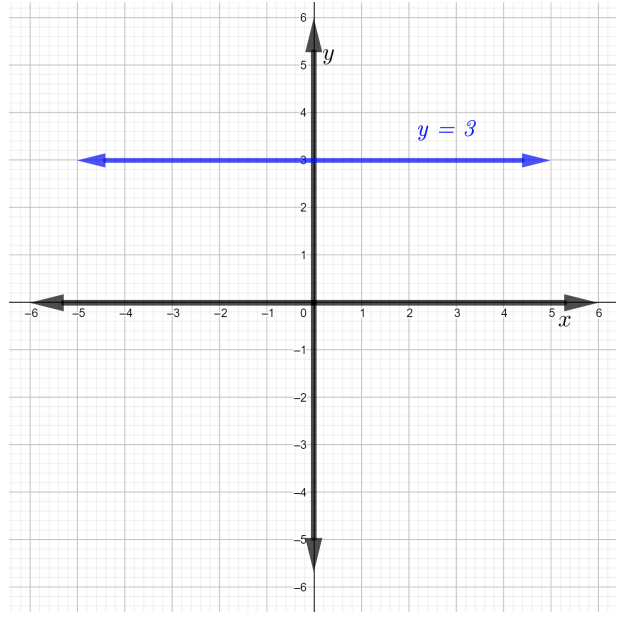7.4: 垂直线和水平线方程
- Page ID
- 171104
垂直线方程的形式为\(x = c\),其中\(c\)是任何实数。 垂直线将始终与该点处的\(x\) −axis 相交\((c, 0)\)。 垂直线的斜率未定义。
找到直线的斜率\(x = 4\)并绘制直线的图形。
解决方案
\(x = 4\)是一条垂直线的图形,如下图所示。

要找到直线的斜率,\(x = 4\)请选择直线上的任意两个不同点。 让分数为 an\((4, −1)\) d\((4, 3)\)。 使用直线公式的斜率,
\(\begin{array} &&m = \dfrac{y_2 − y_1}{x_2 − x_1} &\text{The slope of a line formula} \\ &= \dfrac{3 − (−1)}{4 − 4} &\text{Substitute values} \\ &= \dfrac{4}{0} &\text{Simplify} \end{array}\)
现在,如果\(4\)除以\(0\),这相当于问一个问题:“零乘以多\(4\)少?” 答案是,没有这样的数字。 除以零是未定义的,垂直线的斜率\(x = 4\)未定义。
水平线方程的形式为\(y = k\),其中\(k\)是任何实数。 水平线将始终与该点处的\(y\) −axis 相交\((0, k)\)。 水平线的斜率为零。
找出穿过点的直线的斜率,\((−3, −2)\)然后\((4, −2)\)。 绘制点并绘制穿过它们的线条的图形。
解决方案
使用直线公式的斜率。 因此,
\(\begin{array} &&m = \dfrac{y_2 − y_1}{x_2 − x_1} &\text{The slope of a line formula} \\ &= \dfrac{(−2) − (−2)}{4 − (−3)} &\text{Substitute values} \\ &= \dfrac{0}{7} &\text{Simplify} \\ &= 0 &\text{\(0\)除以任何非零数等于零}\ end {array}\)
因此,穿过两个给定点的直线是一条水平线,斜率等于零,如下图所示。

绘制直线图\(y − 3 = 0\)并找出其斜率。
解决方案
这行\(y − 3 = 0\)可以写成\(y = 3\)(加\(3\)到等式的两边)。 这条线\(y = 3\)是一条水平线,如下图所示。

现在,要找到斜率,请在直线上选择任意两个不同的点\(y = 3\)。 考虑积分\((0, 3)\)和\((3, 3)\). 因此,
\(\begin{array} &&m = \dfrac{y_2 − y_1}{x_2 − x_1} &\text{The slope of a line formula} \\ &= \dfrac{3-3}{3-0} &\text{Substitute values} \\ &= \dfrac{0}{2} &\text{Simplify} \\ &= 0 &\text{\(0\)除以任何非零数等于零}\ end {array}\)
因此,给定线的斜率为\(m = 0.\)
找出每条线的斜率。
- \(x = −\dfrac{1}{2}\)
- \(y − 1 = 0\)
- \(x + 7 = 10\)
- \(y + 2 = −9\)
- 找出穿过点的直线的斜率,\((−4, 1)\)然后\((2, 1)\)。 绘制点并绘制穿过它们的线条的图形。
- 找出穿过点的直线的斜率,\((−3, 5)\)然后\((−3, −7)\)。 绘制点并绘制穿过它们的线条的图形。


